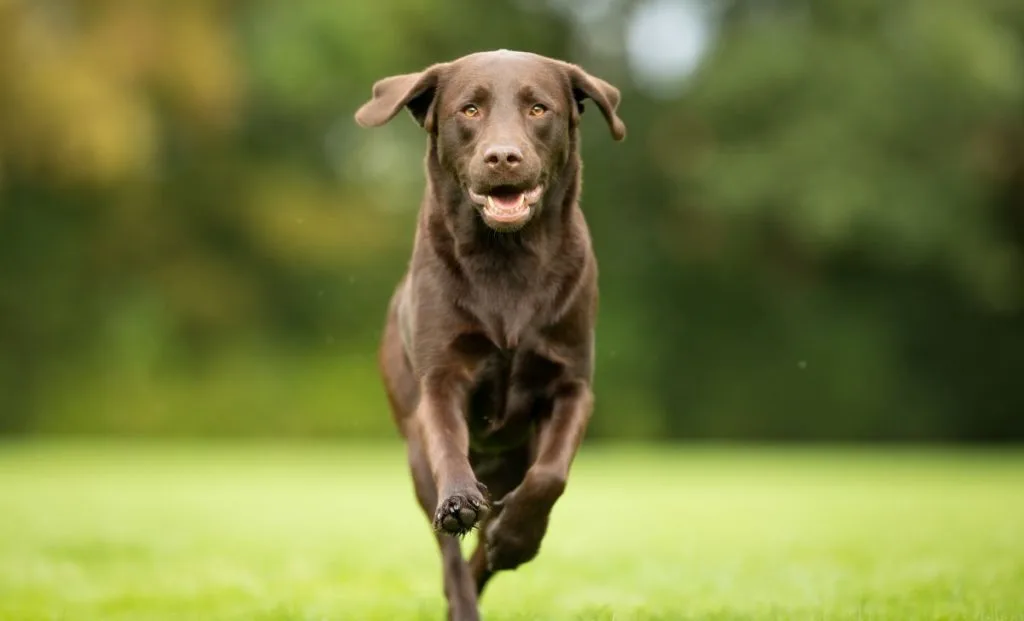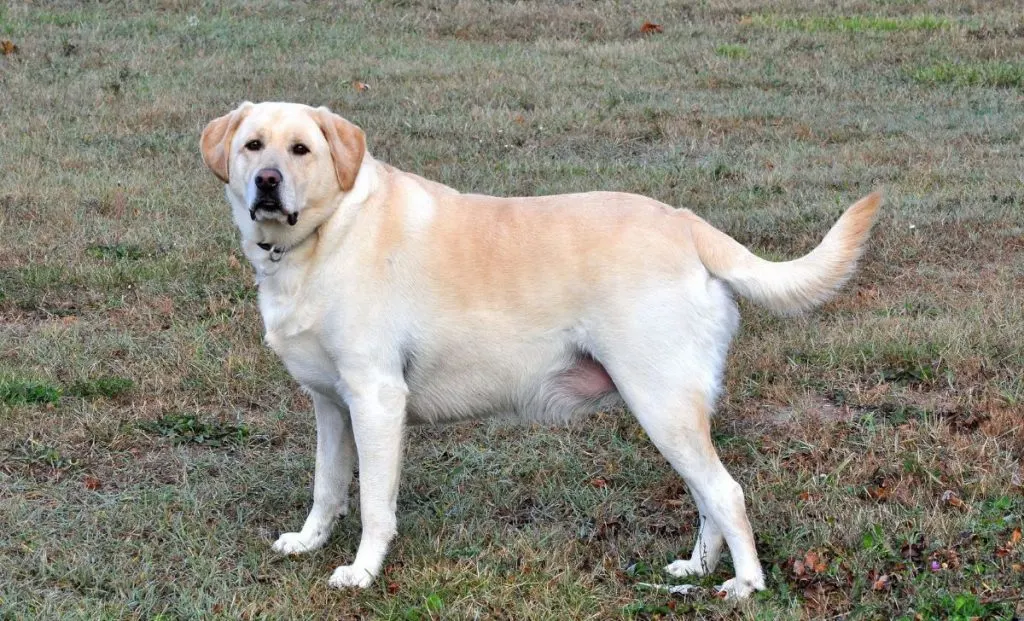All dog owners and dog lovers know about Labs in the color yellow, but what about other Labrador Retriever Colors?
Today, we will talk about Lab colors approved by the American Kennel Club (AKC) and some new colors considered out of standard for this breed.
Spoiler alert: if you ask the AKC – black, chocolate brown, or yellow coats are the only acceptable colors. Lately, however, Labs of various colors have been gaining popularity in the United States.
The Labrador Retrievers hold the number one spot as the most popular dog breed worldwide. They are known for their excellent temperament and friendly, outgoing nature.
With the iconic floppy ears, constantly wagging tail, and soulful, expressive eyes, they exude warmth and charm. Spending time with a Lab makes it easy to see why this breed is in popular demand.
The Labrador Retriever is a versatile dog breed. We can see them as therapy dogs, excellent hunting companions, and even search and rescue dogs. This breed is very athletic and needs a lot of exercise.
Their initial job was retrieving dogs for fishermen, so Labs possessed strong instincts to carry and fetch objects. Those instincts make them excellent companions for outdoor activities like swimming, hiking, and retrieving games.
Thanks to the sturdy build complete with boundless energy, Labradors can thrive in competitions and sports like obedience trials, dock diving, or agility.
This breed possesses intelligence, athleticism, and sociability, enabling it to capture the hearts of dog lovers worldwide continuously.
The Labrador Retriever Color Genetics
As with most dog breeds, the genetics of Lab coat color is quite an interesting subject. When talking about Labrador Retrievers, they have four colors – black, yellow, chocolate, and all colors.
All these colors are determined by a unique series of genes the dog carries. Black Labradors have a dominant black gene, the B locus. Thanks to the B locus, they have their signature black color.
The Chocolate Labrador and the brown Labrador have the b locus gene responsible for the rich chocolate color. The yellow Labs carry an E locus gene that makes their coat yellow.
However, all Labs have a gene that we call A locus. A locus helps determine the intensity of the coat color, regardless of the other three mentioned genes.
So we can thank A locus for the range of colors seen in Labs, from light cream to deep chocolate.
What Are The Three Colors Of Labrador Retrievers
This beloved breed of dog comes in a variety of colors. Today’s most common Labrador color is the conventional chocolate brown, but the American Kennel Club (AKC) recognizes three distinct color variations.
Each of the three colors has its own unique genetic makeup. We can even notice a pattern of some colors being genetically linked to specific health issues.
The black Labrador is generally the most common color variety, and the black Lab is the only type of Lab that can have a dark nose (black) according to the breed standard.
The yellow Labrador coat can vary from a light cream, almost white, to a deep golden color. The only variety of Labs that has brown eyes is the Chocolate Lab.
They usually have a medium to dark brown color on their coat. Silver Labradors also exist; they sport a charcoal grey color with a black nose. The silver Labs have the same genetic makeup as the black Labradors.
The last color we have is the fox red Labradors, which have a deep reddish brown color; they are also the rarest color of the breed.
Understanding the genetics of coat colors can be pretty helpful for dog owners and breeders alike.
If the breeders have proper knowledge of the coat colors, they can work to preserve the most vital genetic traits, thus reducing the risk of any possible health issues.
American Kennel Club Approved Labrador Retriever Colors
Black Labs have the most dominant color in the history of this breed, and if we look deeper into the history, it is easy to see why. Labrador Retriever dogs originate from St. John’s dogs.
All St. John’s dogs have all-black coats with white tuxedo markings that can be found on the chest and paws of the dog.
After multiple generations of Labs reproduced, chocolate Labs and yellow Labradors (recessive gene colors) emerged from some bloodlines.
Breeder Peggy Stanker, owner of Duck Creek, told Outdoor Life that before the 20th century, breeders did not value those colors.
After some time, dog owners and dog breeders alike began to value the chocolate color and yellow color Labs. Soon after, the official kennel clubs began accepting those coat colors as part of the breed standard.
The Lab was first registered as an official breed in the Kennel Club of England in 1903, while in 1917, AKC followed suit and registered them as well.
1. The Black Labradors

As we mentioned, the black Labs have the breed’s original and most popular coat color. They are solid black in color thanks to the dominant e gene.
Eumelanin is the same primary gene present in all Labrador Retrievers, but thanks to some unique genetic variations that affect the black Labs, they have a solid black coat.
One of the genetic variations is the B Locus gene. The B Locus is a dominant gene, which means if the dog has one copy of the gene, it will express black fur as a consequence.
We can also blame the B Locus gene for the absence of other colors in black Labs, as it does not allow the expression of different fur colors.
The other gene we can notice in black Labradors is the E Locus. E Locus produces eumelanin, the pigment that gives black Labs the dark black color.
This is another dominant gene, so if the dog has one copy of the E Locus, it will express itself as black fur.
2. The Chocolate Labrador

While dominant genes cause the black variations, the chocolate color in Labs is caused by a recessive gene. That means both parents must carry the chocolate coat gene to make a chocolate-colored puppy.
It is essential to mention that chocolate Labs are often called brown Labradors, but brown coats and chocolate coats are not the same.
The fur color of a Chocolate Labrador is a deep, dark brown. Nevertheless, the chocolate color might also come in different shades, depending on the parents’ genes.
The Chocolate Labradors, despite the color difference, are just as friendly and intelligent as their black and yellow counterparts. Extremely loyal as they are, they make ideal family pets.
Chocolate pups are known to be very active and energetic, so they need a bunch of exercise and mental stimulation to keep them pleased and healthy.
Overall, the Chocolate Labrador is an excellent dog breed, making it a great companion. Their high intelligence and friendly temperament make them an ideal pet for any family or individual.
3. The Yellow Labrador

At some point in our lives, we all saw the signature yellow coat color on a Lab. The yellow Labs have the widest range of Labrador colour.
They can be almost white Labs or have the deep golden color often associated with Golden Retrievers. Would you have guessed that the genetic makeup of the yellow coat is very complex?
The yellow fur color results from a recessive gene, meaning both parents must have the gene for it to be expressed in their litter of pups.
Depending on the individual dog’s genetic makeup, the coat and fur color can range from pale cream to a red fox color and a deep golden yellow.
Even though the fur color of a yellow Lab is determined by genetics, other factors like health, environment, and nutrition might influence the intensity of the coat color.
If the dog has any underlying health problems, they can affect the vibrancy of the coat as well.
4. The Red Fox Labrador

The red fox Lab is one variation of the yellow Lab.
The hallmark of the red fox Labrador is the deep, reddish-brown coat, with lighter highlights around the legs, chest, and muzzle.
Just like the yellow color, this gorgeous Lab color is caused by a recessive gene.
Thankfully, the red fox Labradors are typically very healthy and live long, with a life expectancy of up to twelve years.
This makes them a pretty popular choice for pet owners looking for a loving, long-lasting companion.
The red fox Labrador variety is a committed and spirited pet, and the stunning coat color is just one of many attractive qualities. The red fox Lab will bring many long years of happiness and companionship with reasonable care and nutrition.
Labrador Retriever Colors Not Accepted By The American Kennel Club
Did you know that the lighter colors of coats, such as silver, champagne, and charcoal, are also a part of the Lab color genetics? They are produced thanks to a genetic mutation called the Dilute Gene.
This gene is a recessive one, so both puppy parents must carry it for the diluted color to show in the coat color of the offspring.
The Dilute Gene is entirely harmless and only influences the coat color of the Labrador, with no known health problems associated with it.
Nonetheless, it is significant to note that not all kennel clubs accept the Dilute Gene, and most consider it a fault.
If you want to add a dilute Lab to your pack, it is vital to research breeders before purchasing a Labrador puppy to confirm that both puppy parents have been tested for the Dilute Gene.
If both parents are carriers, the offspring can have lighter coat colors. If not, the pup is probably a mixed breed, not a purebred Lab.
The Dilute Gene is a harmless mutation to blame for the Labrador’s light fur colors. While these colors are not accepted by all kennel clubs, they are still an exciting and unique part of the Labrador Retriever’s genetics.
What does it mean when the kennel clubs do not accept a color? This makes Labs with those coat colors ineligible for any type of show competition.
5. The Silver Labrador Retriever

This breed’s most rare and unique coat color must be the Silver Labrador. This unusual color results from a recessive gene that is way less common than other colors.
Even though the American Kennel Club (AKC) does not recognize this coat color as a standard Labrador Retriever color, Silver Labradors can be registered with the International Designer Canine Registry (IDCR).
This unique gene and color is a diluted version of the ordinary black Labrador.
The silver gene is a dilution of the eumelanin gene pigment that causes a lightening in the coat color. The silver coat can also result from a white, silver, and gray mixture.
The silver gene is partially dominant. That means it can skip several generations of the dogs before returning to the offspring.
Being rare as they are, Silver Labradors are often mistaken for Weimaraners. Some backyard breeders mix the Weimaraners with Labs to get the rare silver color.
Always look for breeders who are a part of the Labrador Retriever Club. Breeders who are a part of breed clubs are usually ethical and responsible.
The Silver Labradors come in the exact sizes and shapes as their black and chocolate counterparts. Males usually stand between 22 and 24 inches tall, while they weigh between 55 and 75 pounds.
If you would like to read more about Labrador growth and factors that affect it, you can click here.
6. The Champagne Labrador

The Champagne Labrador is again a scarce color variation of the Labrador Retrievers, and it has been gaining popularity in the last few years. These dogs also might have a lighter vanilla color.
This extraordinary color is the outcome of a recessive gene that is passed down from both dog parents. The Champagne Labrador commonly has yellow coat genes, a light brown snout, and light brown eyes.
As you already know, the American Kennel Club does not recognize this color. However, some breeders will register these dogs as a different color (usually yellow)
7. The Charcoal Labrador

The Charcoal Labrador is a remarkable and memorable variation of the Labrador Retriever breed.
These Labs are known for their deep black coat with silver highlights; these dogs result from a recessive gene in the Labrador breed.
Even though the AKC does not recognize the Charcoal Labrador, they have become quite favored as a “designer breed.”
The Charcoal Lab is a stunning variation of the Labrador Retriever and is desired for its unique coat color. The recessive gene that is responsible for the Charcoal color is found in some rare lines of Labs and is passed down from parents to pup.
The popularity of the Charcoal Lab has grown in the last few years as more and more people are looking for unique and eye-catching canines.
The Eumelanin Gene In Labradors
The genetics of Labrador Retriever fur color are incredibly defined by the eumelanin gene.
Eumelanin is a type of melanin that can be found in Labrador Retrievers and other dogs. It is responsible for producing black, brown, and yellow coat colors.
However, the eumelanin gene is not the only gene that can affect coat color; it is the most important one.
The eumelanin gene is inherited from the sire and dam and is passed on to puppies.
A dog with two eumelanin genes will produce a black coat, while a dog that has one eumelanin gene and one that is a non-eumelanin gene will have a chocolate coat color.
Even though the eumelanin gene is the primary determinant of coat color, other genes affect the color of the dogs’ coat, including the genes that produce white spots and markings.
Understanding the genetics of Labrador colors can help breeders and owners better predict their pups’ color. Knowing what exact genes are responsible for coat color can help breeders avoid producing puppies with undesirable colors.
Health Implications And Coat Colors In Labradors
When discussing the genetics of true Labradors and their different coat color, we have three primary colors: black, chocolate, and yellow.
Each of these colors has its own set of associated risks.
For example, the yellow coat color increases the risk of developing certain ear infections and illnesses.
Likewise, the color black coat is linked to an elevated risk of some types of skin cancer in Labs.
Lastly, the color of the chocolate coat is tied to an increased risk of developing some types of eye diseases.
Notably, these risks can be minimized with reasonable care and attention toward the dog. Routine vet visits and early diagnosis are vital for catching and treating any health problems that might arise.
Furthermore, owners of Labs, in general, should make sure that their dog has a healthy diet and a bunch of exercise to help keep them happy and healthy.
Finally, the genetics of Labrador coat color have certain associated risks, but with appropriate care and attention, the dangers can be minimized.
Understanding the chances of illnesses associated with each color can help future dog owners make educated decisions when selecting a Lab puppy to add to their family.

Nandina has been a lifelong dog owner and enthusiast. She shared her home with multiple breeds, including Giant Schnauzers, Cane Corsos, and Huskies. Currently, she is raising a three-year-old rescue and a working-line German Shepherd puppy.
Actively engaged in IGP dog sports for two years, Nandina is a certified instructor for basic obedience and socialization. She works as a trainer in her local dog sports club, and in her spare time, she handicrafts biothane gear for dogs.
